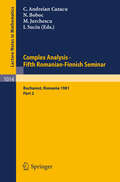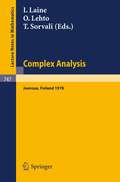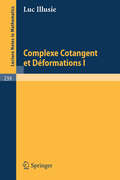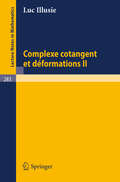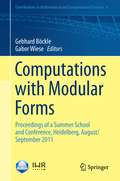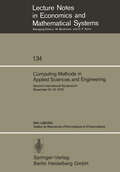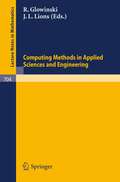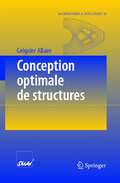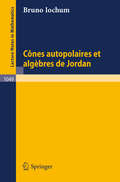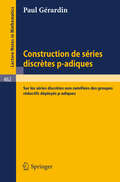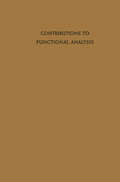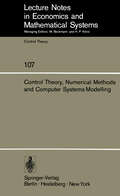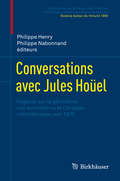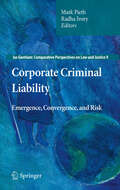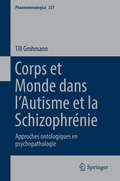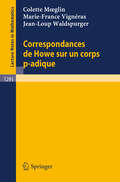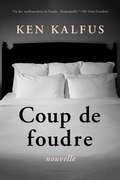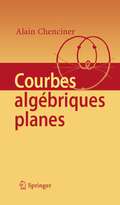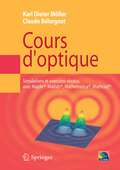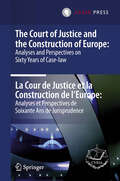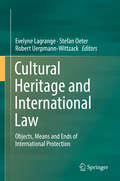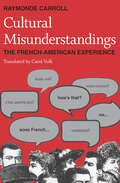- Table View
- List View
Complex Analysis - Fifth Romanian-Finnish Seminar. Proceedings of the Seminar Held in Bucharest, June 28 - July 3, 1981: Part 2 (Lecture Notes in Mathematics #1014)
by C. Andreian Cazacu N. Boboc M. Jurchescu I. SuciuComplex Analysis. Joensuu 1978: Proceedings of the Colloquium on Complex Analysis, Joensuu, Finland, August 24-27, 1978 (Lecture Notes in Mathematics #747)
by I. Laine O. Lehto T. SorvaliRomanian Finnish Seminar on Complex Analysis
Computations with Modular Forms: Proceedings of a Summer School and Conference, Heidelberg, August/September 2011 (Contributions in Mathematical and Computational Sciences #6)
by Gebhard Böckle Gabor WieseThis volume contains original research articles, survey articles and lecture notes related to the Computations with Modular Forms 2011 Summer School and Conference, held at the University of Heidelberg. A key theme of the Conference and Summer School was the interplay between theory, algorithms and experiment.The 14 papers offer readers both, instructional courses on the latest algorithms for computing modular and automorphic forms, as well as original research articles reporting on the latest developments in the field.The three Summer School lectures provide an introduction to modern algorithms together with some theoretical background for computations of and with modular forms, including computing cohomology of arithmetic groups, algebraic automorphic forms, and overconvergent modular symbols.The 11 Conference papers cover a wide range of themes related to computations with modular forms, including lattice methods for algebraic modular forms on classical groups, a generalization of the Maeda conjecture, an efficient algorithm for special values of p-adic Rankin triple product L-functions, arithmetic aspects and experimental data of Bianchi groups, a theoretical study of the real Jacobian of modular curves, results on computing weight one modular forms, and more.
Computing Methods in Applied Sciences and Engineering: Second International Symposium December 15–19, 1975 (Lecture Notes in Economics and Mathematical Systems #134)
by J. L. Lions R. GlowinskiIRIA LABORIA, Institut de Recherche d'Informatique et d'Automatique
Computing Methods in Applied Sciences and Engineering, 1977. Third International Symposium, December 5-9, 1977, IRIA LABORIA, Institut de Recherche d`Informatique et d`Automatique: Part 1 (Lecture Notes in Mathematics #704)
by R. Glowinski J. L. LionsConception optimale de structures (Mathématiques et Applications #58)
by Grégoire AllaireConception optimale des structures est une introduction à la conception optimale de structures, appelée aussi optimisation de formes. Il est principalement destiné à un public mixte de mathématiciens appliqués et de mécaniciens que relient un même intérêt pour les applications numériques.
Construction de Series Discretes p-adiques: "Sur les Series Discretes non Ramifiees des Groupes Reductifs Deployes p-adiques" (Lecture Notes in Mathematics #462)
by P. GerardinContributions to Functional Analysis
by Harro Heuser R. E. Fullerton C. C. Braunschweiger Ebbe Thue Poulsen Jean Leray Gregers Krabbe Anastasios Mallios Tosio Kato Felix E. Browder Takako Kōmura Yukio Kōmura Helmut H. Schaefer Kosaku Yosida Nelson Dunford Joseph Nieto W. A. Luxemburg A. C. Zaanen J. L. Cooper R. S. Bucy G. Maltese Jean Dieudonné H. G. Garnir Heinz König Angus E. Taylor Max Landsberg Thomas Riedrich E. Michael A. Martineau J. L. Kelley Vlastimil Pták Shozo Koshi Horst Leptin H. Reiter L. Waelbroeck N. Aronszajn P. Szeptycki Richard Arens Czeslaw Bessaga Victor Klee Hidegoro Nakano Joseph Wloka Ky Fan Hubert Berens P. L. Butzer H. O. Cordes Stefan Hildebrandt Gerhard Neubauer J. B. Diaz F. T. Metcalf Günter Ewald M. A. Naǐmark Elmar Thoma Bernhard GramschControl Theory, Numerical Methods and Computer Systems Modelling: International Symposium, Rocquencourt, June 17–21, 1974 (Lecture Notes in Economics and Mathematical Systems #107)
by J. L. Lions A. BensoussanConversations avec Jules Hoüel: Regards sur la géométrie non euclidienne et l’analyse infinitésimale vers 1875 (Publications des Archives Henri Poincaré Publications of the Henri Poincaré Archives)
by Philippe Henry Philippe NabonnandCet ouvrage contient les correspondances actives et passives de Jules Hoüel avec Joseph-Marie De Tilly, Gaston Darboux et Victor-Amédée Le Besgue ainsi qu’une introduction qui se focalise sur la découverte de l’impossibilité de démontrer le postulat des parallèles d’Euclide et l’apparition des premiers exemples de fonctions continues non dérivables.Jules Hoüel (1823-1886) a occupé une place particulière dans les mathématiques en France durant la seconde partie du 19ème siècle. Par ses travaux de traduction et ses recensions, il a vivement contribué à la réception de la géométrie non euclidienne de Bolyai et Lobatchevski ainsi qu’aux débats sur les fondements de l’analyse. Il se situe au centre d’un vaste réseau international de correspondances en lien avec son rôle de rédacteur pour le Bulletin des sciences mathématiques et astronomiques.
Corporate Criminal Liability: Emergence, Convergence, and Risk (Ius Gentium: Comparative Perspectives on Law and Justice #9)
by Mark Pieth and Radha IvoryWith industrialization and globalization, corporations acquired the capacity to influence social life for good or for ill. Yet, corporations are not traditional objects of criminal law. Justified by notions of personal moral guilt, criminal norms have been judged inapplicable to fictional persons, who ‘think’ and ‘act’ through human beings. The expansion of new corporate criminal liability (CCL) laws since the mid-1990s challenges this assumption. Our volume surveys current practice on CCL in 15 civil and common law jurisdictions, exploring the legal conditions for liability, the principles and options for sanctioning, and the procedures for investigating, charging and trying corporate offenders. It considers whether municipal CCL laws are converging around the notion of ‘corporate culture’, and, in any case, the implications of CCL for those charged with keeping corporations, and other legal entities, out of trouble.
Corps et Monde dans l’Autisme et la Schizophrénie: Approches ontologiques en psychopathologie (Phaenomenologica #227)
by Till GrohmannLe livre offre une investigation phénoménologique des traits caractéristiques des troubles du spectre de l'autisme et de la schizophrénie. Son matériel de base sont des écrits autobiographiques ainsi que des descriptions de patients en première personne. L’objectif principal de cette investigation est double: premièrement, de systématiquement élaborer la corrélation fondamentale entre le corps et le monde; deuxièmement, de comprendre autisme et schizophrénie comme des transformations typiques de cette corrélation. L’auteur interroge schizophrénie et autisme comme des transformations comparables, mais néanmoins fondamentalement distinctes, de la structure ambivalente du corps propre. Il combine une lecture de philosophie phénoménologique avec des approches provenant de la psychiatrie et de la psychopathologie. L’analyse phénoménologique de la corporéité amène l’auteur à analyser une double structure expérientielle, faite de vécus subjectifs et objectifs du corps. En référence à ce paradigme, autisme et schizophrénie apparaissent comme des possibles destins de la structure ambivalente du corps. Un rôle majeur est ici attribué à la spatialisation, c’est-à-dire aux différents modes de vivre et de représenter l’espace.
Correspondances de Howe sur un corps p-adique (Lecture Notes in Mathematics #1291)
by Colette Moeglin Marie-France Vignéras Jean-Loup WaldspurgerThis book grew out of seminar held at the University of Paris 7 during the academic year 1985-86. The aim of the seminar was to give an exposition of the theory of the Metaplectic Representation (or Weil Representation) over a p-adic field. The book begins with the algebraic theory of symplectic and unitary spaces and a general presentation of metaplectic representations. It continues with exposés on the recent work of Kudla (Howe Conjecture and induction) and of Howe (proof of the conjecture in the unramified case, representations of low rank). These lecture notes contain several original results. The book assumes some background in geometry and arithmetic (symplectic forms, quadratic forms, reductive groups, etc.), and with the theory of reductive groups over a p-adic field. It is written for researchers in p-adic reductive groups, including number theorists with an interest in the role played by the Weil Representation and -series in the theory of automorphic forms.
Coup de foudre: nouvelle
by Ken KalfusDans Coup de foudre, le célèbre auteur d'Un désordre américain (sélection 2006 du National Book Award), nous livre le genre d'œuvre explosive d'invention et de provocation littéraires que ses lecteurs attendent désormais de lui. Cette nouvelle provocatrice, d'actualité, est l'histoire tantôt farcesque, tantôt tragique, du président d'un établissement de prêt transnational accusé d'avoir violé une femme de chambre d'un hôtel new-yorkais. Evoquant l'actualité avec ironie et compassion, Kalfus jette un regard perçant sur les mécanismes politiques internationaux et l'hypocrisie des relations sexuelles.Mêlant intelligence, sens de l'humour distinctif et ambitions littéraires, Coup de foudre nous montre Kalfus en pleine possession de ses moyens.
Courbes Algébriques Planes
by Alain ChencinerIssu d’un cours de maîtrise de l’Université Paris VII, ce texte est réédité tel qu’il était paru en 1978. A propos du théorème de Bézout sont introduits divers outils nécessaires au développement de la notion de multiplicité d’intersection de deux courbes algébriques dans le plan projectif complexe. Partant des notions élémentaires sur les sous-ensembles algébriques affines et projectifs, on définit les multiplicités d’intersection et interprète leur somme entermes du résultant de deux polynômes. L’étude locale est prétexte à l’introduction des anneaux de série formelles ou convergentes ; elle culmine dans le théorème de Puiseux dont la convergence est ramenée par des éclatements à celle du théorème des fonctions implicites. Diverses figures éclairent le texte: on y "voit" en particulier que l’équation homogène x3+y3+z3 = 0 définit un tore dans le plan projectif complexe.
Cours d'optique: Simulations et exercices résolus avec Maple®, Matlab®, Mathematica®, Mathcad®
by Karl Dieter Moeller Claude BélorgeotCet ouvrage s'adresse aux étudiants des niveaux L et M de l'université ainsi qu'aux ingénieurs désireux d'approfondir certains sujets. Il couvre tous les thèmes d'un cours d'optique traditionnel, de l'optique géométrique à l'holographie, en passant par les interférences, la diffraction, la cohérence et l'utilisation de la transformée de Fourier pour la spectroscopie. L'exposé est développé à partir de modèles mathématiques dérivant de situations typiques et d'exemples fondamentaux qui sont présentés sous forme de programmes informatiques prêts à être mis en œuvre. Ces programmes sont aussi disponibles sur le CD accompagnant l'ouvrage, pour chacun des environnements de programmation scientifiques suivants: Matlab, Maple, Mathematica et Mathcad. Ainsi, le lecteur pourra modifier les paramètres des exemples proposés pour les adapter à de nouvelles situations. (Une mise à jour de ces programmes pour Mathematica Version 6 est disponible sur le site internet de l'auteur (voir rubrique contenu électronique à droite)). L'originalité de cet ouvrage consiste en une présentation succincte des équations fondamentales de l'optique sous forme de rappels de cours, illustrées par des exemples développés et des programmes les mettant en œuvre. Il est ainsi particulièrement adapté à l'auto-apprentissage. Il sera aussi très utile pour mettre en œuvre des travaux pratiques et des simulations sur ordinateur.
The Court of Justice and the Construction of Europe: Analyses and Perspectives on Sixty Years of Case-law -La Cour de Justice et la Construction de l'Europe: Analyses et Perspectives de Soixante Ans de Jurisprudence
by A. Rosas E. Levits Y. BotThis book is a contributed volume published by the Court of Justice of the European Union on the occasion of its 60th anniversary. It provides an insight to the 60 years of case-law of the Court of Justice and its role in the progress of European Integration. The book includes contributions from eminent jurists from almost all the EU Member States. All the main areas of European Union are covered in a systematic way. The contributions are regrouped in four chapters dedicated respectively to the role of the Court of Justice and the Judicial Architecture of the European Union, the Constitutional Order of the European Union, the Area of EU Citizens and the European Union in the World. The topics covered remain of interest for several years to come. This unique book, a "must-have" reference work for Judges and Courts of all EU Members States and candidate countries, and academics and legal professionals who are active in the field of EU law, is also valuable for Law Libraries and Law Schools in Europe, the United States of America, Latin America, Asia and Africa and law students who focus their research and studies in EU law.
Cultural Heritage and International Law: Objects, Means and Ends of International Protection
by Evelyne Lagrange Stefan Oeter Robert Uerpmann-WittzackThis book explores the objects, means and ends of international cultural heritage protection. It starts from a broad conception of cultural heritage that encompasses both tangible property, such as museum objects or buildings, and intangible heritage, such as languages and traditions. Cultural heritage thus defined is protected by various legal regimes, including the law of armed conflicts, UNESCO Conventions and international criminal law. With a view to strengthening international protection, the authors analyze existing regimes and elaborate innovative concepts, such as blue helmets of culture and safe havens for endangered cultural heritage. Finally, the ends of international protection come to the fore, and the authors address possible conflicts between protecting cultural diversity and wishes to strengthen cultural identity.
Cultural Misunderstandings: The French-American Experience
by Raymonde CarrollRaymonde Carroll presents an intriguing and thoughtful analysis of the many ways French and Americans—and indeed any members of different cultures—can misinterpret each other, even when ostensibly speaking the same language. Cultural misunderstandings, Carroll points out, can arise even where we least expect them—in our closest relationships. The revealing vignettes that Carroll relates, and her perceptive comments, bring to light some fundamental differences in French and American presuppositions about love, friendship, and raising children, as well as such everyday activities as using the telephone or asking for information.
Cultural Misunderstandings: The French-American Experience
by Raymonde CarrollRaymonde Carroll presents an intriguing and thoughtful analysis of the many ways French and Americans—and indeed any members of different cultures—can misinterpret each other, even when ostensibly speaking the same language. Cultural misunderstandings, Carroll points out, can arise even where we least expect them—in our closest relationships. The revealing vignettes that Carroll relates, and her perceptive comments, bring to light some fundamental differences in French and American presuppositions about love, friendship, and raising children, as well as such everyday activities as using the telephone or asking for information.
Cultural Misunderstandings: The French-American Experience
by Raymonde CarrollRaymonde Carroll presents an intriguing and thoughtful analysis of the many ways French and Americans—and indeed any members of different cultures—can misinterpret each other, even when ostensibly speaking the same language. Cultural misunderstandings, Carroll points out, can arise even where we least expect them—in our closest relationships. The revealing vignettes that Carroll relates, and her perceptive comments, bring to light some fundamental differences in French and American presuppositions about love, friendship, and raising children, as well as such everyday activities as using the telephone or asking for information.
Cultural Misunderstandings: The French-American Experience
by Raymonde CarrollRaymonde Carroll presents an intriguing and thoughtful analysis of the many ways French and Americans—and indeed any members of different cultures—can misinterpret each other, even when ostensibly speaking the same language. Cultural misunderstandings, Carroll points out, can arise even where we least expect them—in our closest relationships. The revealing vignettes that Carroll relates, and her perceptive comments, bring to light some fundamental differences in French and American presuppositions about love, friendship, and raising children, as well as such everyday activities as using the telephone or asking for information.
